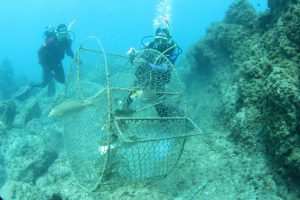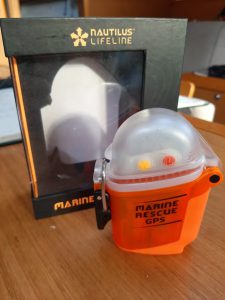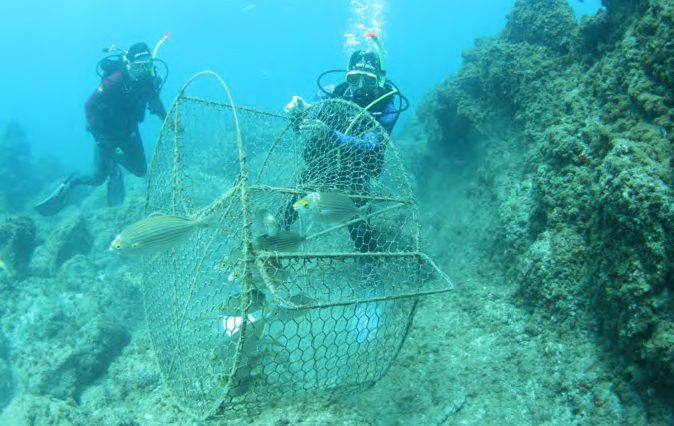Captain log: October 11th, 2021
Location: Canary Islands, Puerto San Miguel, South Tenerife, Atlantic Ocean
The crew is still trying to wrap their heads around the momentum of Mother Nature’s volcanic eruption, during our visit to the island of La Palma (as discussed in Sources October 14th Issue). Having moved on, and wound up diving in Bajonita, a bay located in the south of the island Tenerife, with our on-board guests, Geert and Didier, we encountered several ghost-nets.
What are ghost-nets?
As I write this log, I notice that Halloween is coming up, but believe me, this is NOT your average Halloween story! Ghost-nets are fishing nets that are lost during use!
Several causes for this to happen can be:
- detachment of the surface buoys needed to recover the nets
- displacement of the nets due to storms
- detachment of the marker lines to recover/find back the nets
- sudden breaking up of the net in several pieces (bad quality or too long in use)
The problem with ghost-nets is that they ‘keep on fishing’. As long as they stay in the water, they keep on trapping fish and so keep on killing fish uselessly. They also can pose a danger to scuba divers. As the nets can be freely floating around in the ocean, a scuba diver can be badly surprised by a floating net, being dragged by current in any direction and ending up entangling the diver in the ghost-net! It can quickly become a very dangerous situation, in which you need your dive knife, and you need to know how to handle it.
A good practice run on your next training dive, (or ask your local NAUI dive center/dive instructor) would be to simulate an entanglement situation with some fishing line or a piece of fishing net and cut yourself free, but make sure you have a back up diver/supervisor with you, to make sure that your simulation stays a simulation and doesn’t end up being a real emergency.
Back to our ghost-nets in Tenerife:
 During many of our scuba dives we encountered floating nets but also steel man-made fish traps (box sized or circular). Normally these fish traps are lowered to the bottoms of the sea for several hours to catch fish or even crabs/lobsters (such as seen on the National Geographic series Deadliest Catch). As the fisherman need to recuperate these traps after soaking them for hours on the oceanbed, they mark them with surface makers,buoys or even GPS trackers. The problem here is that these markers, trackers can get stolen, leaving the fish-trap ‘forever’ on the bottom of the ocean! As one fish will enter the trap and finally will die inside of pure starvation, the next scavenger fish will come in to eat the remains of the first fishy victim and guess what, the same fate occurs and the circle continues! The fish-trap will never stop killing ocean-life needlessly.
During many of our scuba dives we encountered floating nets but also steel man-made fish traps (box sized or circular). Normally these fish traps are lowered to the bottoms of the sea for several hours to catch fish or even crabs/lobsters (such as seen on the National Geographic series Deadliest Catch). As the fisherman need to recuperate these traps after soaking them for hours on the oceanbed, they mark them with surface makers,buoys or even GPS trackers. The problem here is that these markers, trackers can get stolen, leaving the fish-trap ‘forever’ on the bottom of the ocean! As one fish will enter the trap and finally will die inside of pure starvation, the next scavenger fish will come in to eat the remains of the first fishy victim and guess what, the same fate occurs and the circle continues! The fish-trap will never stop killing ocean-life needlessly.
Yet, there is another point to consider: the value of the fish-trap! As scuba divers, we could simply destroy the fish-trap and be done with it. But the fishermen do have a life to live and need to earn money to provide food to their families, they will need to replace the lost fish-traps somehow, either they’ll need to construct new ones or buy them. But there may be an alternative option.
And yes, that is exactly were we come in. As scuba divers on-board SY Blowing Bubbles, we carry special safety devices like the ‘Nautilus Lifeline’ (Marine Rescue GPS).With this device, we were able to send out a GPS tracking signal, to find these lost fish-traps. After finding the lost fish-traps, we can easily ‘mark’ their position with our Marine Rescue GPS and restore the value of the fish-trap by handing the GPS coordinates to the local fishermen, who then can recapture the fish-trap (but all of this was not done before we had ‘closed’ the entrance of the fish-trap so it would immediately stop killing ocean life). The fishermen were extremely happy with our GPS donation and in return, not only some happy smiles but also some “dive bellies” were later being filled with some delicious fish, back on-board the SY Blowing Bubbles, using our barbecue! A win-win story! And as far as ghost-nets go, get some training with your local NAUI dive centre or instructor and get a proper dive knife to join you on your future dives as fishing lines, ghost-nets and more are never too far away from us scuba divers.


